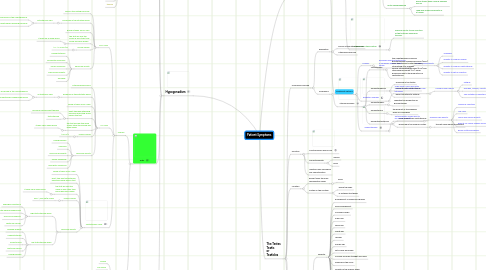
1. Hypogonadism
1.1. Symptoms
1.1.1. sexual problems
1.1.2. breast enlargement
1.1.3. growth problems
1.1.4. hair growth problems
1.1.5. muscle growth problems
1.1.6. reduced sex drive
1.2. Causes
1.2.1. Primary causes involving the Testes
1.2.1.1. certain autoimmune disorders
1.2.1.2. genetic and developmental problems
1.2.1.3. infection(s)
1.2.1.4. Liver/Kidney diseases
1.2.1.5. high levels of radiation
1.2.1.6. surgery
1.2.1.7. common genetic disorders
1.2.1.7.1. Turner syndrome
1.2.1.7.2. Klinefelter syndrome
1.2.2. Causes involving the Hypothalamus and Pituitary gland
1.2.2.1. certain medications
1.2.2.1.1. steroids
1.2.2.1.2. opiates
1.2.2.2. genetic problems
1.2.2.3. infections
1.2.2.4. nutritional disorders
1.2.2.5. iron excess
1.2.2.5.1. hemochromatosis
1.2.2.6. high levels of radiation
1.2.2.7. rapid,significant weight lost
1.2.2.8. surgery
1.2.2.9. trauma
1.2.2.10. tumors
1.3. Tests
1.3.1. Primary
1.3.1.1. FSH Level
1.3.1.1.1. follicle-stimulating hormone
1.3.1.1.2. produced in the pituitary gland
1.3.1.1.3. Blood is taken from a vein
1.3.1.1.4. the test will feel the same as any other time blood has been drawn
1.3.1.1.5. normal values
1.3.1.1.6. abnormal results
1.3.1.2. LH Level
1.3.1.2.1. luteinizing hormones
1.3.1.2.2. produced in the pituitarty gland
1.3.1.2.3. Blood is taken from a vein
1.3.1.2.4. don't take any luteinzing hormone effecting drugs before the test
1.3.1.2.5. the test will feel the same as any other time blood has been drawn
1.3.1.2.6. nomral values
1.3.1.2.7. abnormal results
1.3.1.3. Testosterone Level
1.3.1.3.1. Blood is taken from a vein
1.3.1.3.2. don't take any testosterone effecting drugs before test
1.3.1.3.3. the test will feel the same as any other time blood has been drawn
1.3.1.3.4. normal values
1.3.1.3.5. abnormal results
1.3.2. other test
1.3.2.1. anenia
1.3.2.2. iron levels
1.3.2.3. gentetics
1.3.2.4. sperm count
1.3.2.5. thyroid levels
1.4. Treatment
1.4.1. add testosterone
1.4.1.1. patch
1.4.1.1.1. enters through skin
1.4.1.1.2. enters through gums
1.4.1.2. gel
1.4.1.2.1. enters through skin
1.4.1.3. injection
1.4.1.3.1. enters through veins
2. Testicular Cancer
2.1. Symptoms
2.1.1. Lump or swelling in either testicle
2.1.2. Enlargement of testicle or change in the way it feels
2.1.3. Discomfort or pain in the testicle
2.1.4. Feeling of heaviness in the scrotum
2.1.5. Pain in lower abdomen or back
2.1.6. Excess development of breast tissue
2.1.7. Reduced Sex Drive
2.2. Causes
2.2.1. Abnormal testicle development
2.2.2. History of testicular cancer
2.2.3. History of undescended testicle
2.2.4. Klinefelter Syndrome
2.2.5. HIV inection
2.3. Tests
2.3.1. Abdominal and pelvic CT scan
2.3.1.1. To see tumours in pelvic region
2.3.1.2. Abdominal CT scan to check if cancer has spread to the lungs
2.3.1.3. Positive = cancer Negative = no cancer
2.3.2. Blood tests for tumour markers
2.3.2.1. alpha fetoprotein
2.3.2.1.1. AFP is a protein found in the bloodstream of some men with testicular cancer. A blood test can possibly measure the progress of the disease and success of treatment.
2.3.2.1.2. Higher levels means the further along the cancer is
2.3.2.2. human chorionic gonadotrophin
2.3.2.2.1. Testicular tumors can secrete high levels of HCG, which stimulates breast development. Can be detected by a blood test
2.3.2.2.2. High levels means high probability of Cancer
2.3.2.3. lactic dehydrogenase
2.3.2.3.1. An enzyme which is released into the blood stream when cellular damage occurs.
2.3.2.3.2. High level means possibility of a tumour
2.3.3. Ultrasound of the scrotum
2.3.3.1. Allows a doctor to see a picture of the testicles looking for tumours
2.4. Treatment Options
2.4.1. Surgery
2.4.1.1. Removes infected testicle and if necessary nearby lymph nodes
2.4.1.1.1. Possible Side Effects
2.4.2. Radiation Therapy
2.4.2.1. High-dose x-rays used after surgery to prevent the tumour from returning
2.4.2.1.1. Possible Side Effects
2.4.3. Chemotherapy
2.4.3.1. Antineoplastic drugs used to kill cancerous cells
2.4.3.1.1. Possible Side Effects
3. The Testes Testis or Testicles
3.1. Hormones Invlovled
3.1.1. Regulation
3.1.1.1. Follicle-Stimulatiing hormone
3.1.1.2. Luteinizing hormone
3.1.2. Androgens
3.1.2.1. Steroid hormone
3.1.2.1.1. Testosterone
3.1.2.1.2. Androstenedione
3.1.2.1.3. Androstenediol
3.1.2.1.4. Androsterone
3.1.2.1.5. Dihydrotestosterone
3.2. Function
3.2.1. Functioning of sperm cells
3.2.2. Promote growth
3.2.2.1. muscle
3.2.2.2. bone
3.2.3. maintain male secondary sex characteristics
3.3. Location
3.3.1. below/under the male reproductive organ
3.3.1.1. Penis
3.3.2. contain in the scrotum
3.3.2.1. below the body
3.3.2.2. in between the thighs
3.4. Effect by hormone
3.4.1. Pubertal
3.4.1.1. Enlargement of Sebaceous glands
3.4.1.2. Penis enlargement
3.4.1.3. Increased Libido
3.4.1.4. Pubic hair
3.4.1.5. Facial hair
3.4.1.6. Chest hair
3.4.1.7. Leg hair
3.4.1.8. Axillary hair
3.4.1.9. Fat in face decreases
3.4.1.10. Increase muscles strenght and mass
3.4.1.11. Deeping of the voice
3.4.1.12. Growth of the Adam's apple
3.4.1.13. Growth of spermatogenic tissue in testicles,
3.4.1.14. Growth of facial bone contours
3.4.1.15. Shoulder become broader
3.4.1.16. Rib cage expans
3.4.1.17. Bone maturation
3.4.1.18. Termination of growth
3.4.2. Adult
3.4.2.1. Sperm development
3.4.2.2. Mental and Physical health
3.4.2.3. Maintian muscles
3.4.2.4. Libido
3.4.2.5. Fight-or-flight response
3.4.2.6. Risk taking
3.4.2.7. Strength of Immune system
3.5. Common diseases/disorders
3.5.1. Testicular Trauma
3.5.1.1. Trauma to the Testicles
3.5.2. Testicular Torsion
3.5.2.1. Spermatic cord gets cut
3.5.3. Testicular Cancer
3.5.3.1. Cancer of the Testicles
3.5.4. Epididymitis
3.5.4.1. Inflammation of the epididymis
3.5.5. Hypogonadism
3.5.5.1. Low Testosterone
3.5.6. Klinefelter’s syndrome
3.5.6.1. extra X chromosome
3.5.7. Undescended testicles
3.5.7.1. Testicles didn't descended
3.5.8. Hemochromatosis
3.5.8.1. Too much iron in the blood
3.5.8.1.1. may lead to Testicles of Pituitary gland not functioning
3.5.9. Pituitary disorders
3.5.9.1. Head injury or Pituitary tumor
